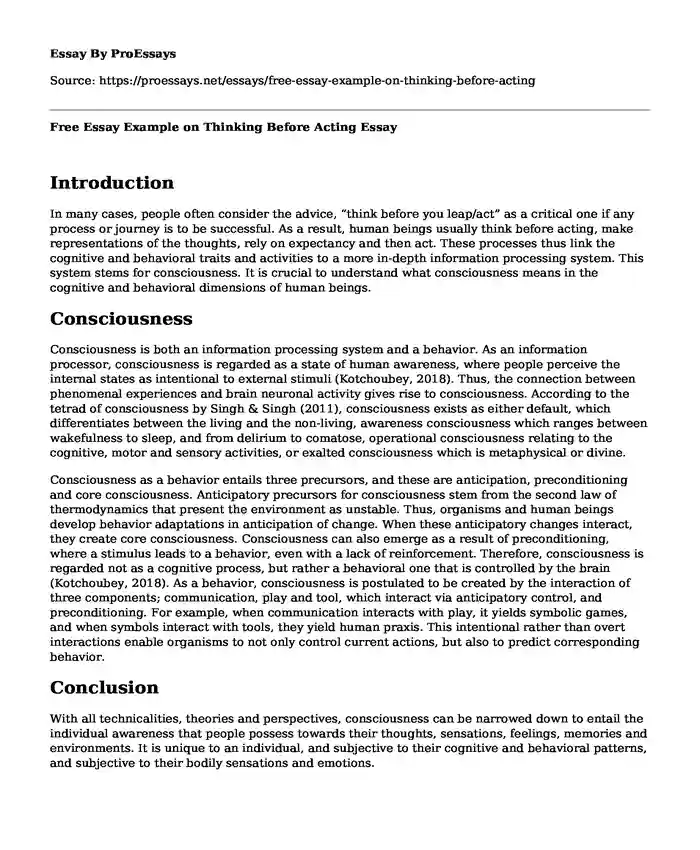Introduction
In many cases, people often consider the advice, “think before you leap/act” as a critical one if any process or journey is to be successful. As a result, human beings usually think before acting, make representations of the thoughts, rely on expectancy and then act. These processes thus link the cognitive and behavioral traits and activities to a more in-depth information processing system. This system stems for consciousness. It is crucial to understand what consciousness means in the cognitive and behavioral dimensions of human beings.
Consciousness
Consciousness is both an information processing system and a behavior. As an information processor, consciousness is regarded as a state of human awareness, where people perceive the internal states as intentional to external stimuli (Kotchoubey, 2018). Thus, the connection between phenomenal experiences and brain neuronal activity gives rise to consciousness. According to the tetrad of consciousness by Singh & Singh (2011), consciousness exists as either default, which differentiates between the living and the non-living, awareness consciousness which ranges between wakefulness to sleep, and from delirium to comatose, operational consciousness relating to the cognitive, motor and sensory activities, or exalted consciousness which is metaphysical or divine.
Consciousness as a behavior entails three precursors, and these are anticipation, preconditioning and core consciousness. Anticipatory precursors for consciousness stem from the second law of thermodynamics that present the environment as unstable. Thus, organisms and human beings develop behavior adaptations in anticipation of change. When these anticipatory changes interact, they create core consciousness. Consciousness can also emerge as a result of preconditioning, where a stimulus leads to a behavior, even with a lack of reinforcement. Therefore, consciousness is regarded not as a cognitive process, but rather a behavioral one that is controlled by the brain (Kotchoubey, 2018). As a behavior, consciousness is postulated to be created by the interaction of three components; communication, play and tool, which interact via anticipatory control, and preconditioning. For example, when communication interacts with play, it yields symbolic games, and when symbols interact with tools, they yield human praxis. This intentional rather than overt interactions enable organisms to not only control current actions, but also to predict corresponding behavior.
Conclusion
With all technicalities, theories and perspectives, consciousness can be narrowed down to entail the individual awareness that people possess towards their thoughts, sensations, feelings, memories and environments. It is unique to an individual, and subjective to their cognitive and behavioral patterns, and subjective to their bodily sensations and emotions.
References
Kotchoubey B. (2018). Human Consciousness: Where Is It From and What Is It for. Frontiers in psychology, 9, 567. https://doi.org/10.3389/fpsyg.2018.00567
Singh, A. R., & Singh, S. A. (2011). Brain-mind dyad, human experience, the consciousness tetrad and lattice of mental operations: and further, the need to integrate knowledge from diverse disciplines. Mens sana monographs, 9(1), 6–41. https://doi.org/10.4103/0973-1229.77412.
Cite this page
Free Essay Example on Thinking Before Acting. (2023, Nov 16). Retrieved from https://proessays.net/essays/free-essay-example-on-thinking-before-acting
If you are the original author of this essay and no longer wish to have it published on the ProEssays website, please click below to request its removal:
- Psychotropic in Children - Assignment Example
- Research Paper on Beauty Societal Standards
- Paper Example on Celebrating Milly Ambrose: A Tribute to a Beloved Grandmother
- Essay on PMHNP: Diagnostic Assessment & Treatment for Psychiatric Disorders
- Essay Example on the Changing Landscape of Love: From Sacred Institution to Modern Society
- Essay Sample on Aging: A Global Journey of Cumbersome Dynamics and Respect
- Free Report Sample on MBTI: Purpose, Construct, Strengths & Weaknesses







